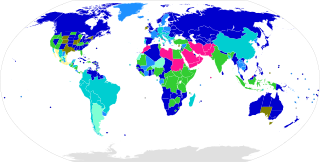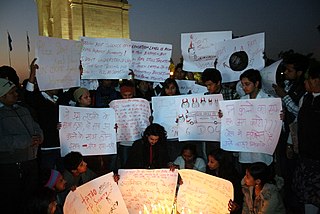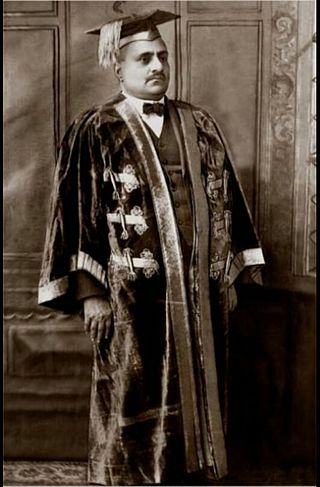
The age of consent is the age at which a person is considered to be legally competent to consent to sexual acts. Consequently, an adult who engages in sexual activity with a person younger than the age of consent is unable to legally claim that the sexual activity was consensual, and such sexual activity may be considered child sexual abuse or statutory rape. The person below the minimum age is considered the victim, and their sex partner the offender, although some jurisdictions provide exceptions through "Romeo and Juliet laws" if one or both participants are underage and are close in age.
The Uniform Civil Code is a proposal in India to formulate and implement personal laws of citizens which apply on all citizens equally regardless of their religion. Currently, personal laws of various communities are governed by their religious scriptures. Implementation of a uniform civil code across the nation is pursued by India's governing Bharatiya Janata Party. Personal laws cover marriage, divorce, inheritance, adoption and maintenance. While articles 25-28 of the Indian Constitution guarantee religious freedom to Indian citizens and allow religious groups to maintain their own affairs, article 44 expects the Indian state to apply directive principles and common law for all Indian citizens while formulating national policies.
Child marriage is a marriage or domestic partnership, formal or informal, between a child and an adult, or between a child and another child.

The status of women in India has been subject to many changes over the time of recorded India's history. Their position in society deteriorated early in India's ancient period, especially in the Indo-Aryan speaking regions, and their subordination continued to be reified well into India's early modern period.
The Nehru Report of 1928 was a memorandum by All Parties Conference in British India to appeal for a new dominion status and a federal set-up of government for the constitution of India. It also proposed for the Joint Electorates with reservation of seats for minorities in the legislatures.

Muthulakshmi Reddy was an Indian medical practitioner, social reformer and Padma Bhushan award recipient.

Feminism in India is a set of movements aimed at defining, establishing, and defending equal political, economic, and social rights and opportunities for women in India. It is the pursuit of women's rights within the society of India. Like their feminist counterparts all over the world, feminists in India seek gender equality: the right to work for equality in wages, the right to equal access to health and education, and equal political rights. Indian feminists also have fought against culture-specific issues within India's patriarchal society, such as inheritance laws.
Satyendra Chandra Mitra was an Indian freedom fighter, who started his political career as a revolutionary aligning himself with the Jugantar Party. In 1916 he was arrested and interned at Janjira Char, located in the midst of the Padma River and was subsequently released after the Great War. Continuing his studies he qualified as an Advocate in the High Court of Calcutta and joined the Swaraj Party, founded by Deshabandhu Chittaranjan Das.

Sir Hari Singh Gour was a distinguished lawyer, jurist, educationist, social reformer, poet, and novelist. Gour was the First Vice-Chancellor of the University of Delhi and Nagpur University, founder and Vice-Chancellor of the University of Sagar, Deputy President of the Central Legislative Assembly of British India, an Indian Delegate to the Joint Parliamentary Committee, a Member of the Indian Central Committee associated with the Royal Commission on the Indian Constitution, and a Fellow of the Royal Society of Literature.
The Age of Consent Act, 1891, also known as Act X of 1891, was a legislation enacted in British India on 19 March 1891 which raised the age of consent for sexual intercourse for all girls, married or unmarried, from ten to twelve years in all jurisdictions, its violation subject to criminal prosecution as rape. The act was an amendment of the Indian Penal Code and Code of Criminal Procedure, Section 375, 1882,, and was introduced as a bill on 9 January 1891 by Sir Andrew Scoble in the Legislative Council of the Governor-General of India in Calcutta. It was debated the same day and opposed by council member Sir Romesh Chunder Mitter on the grounds that it interfered with orthodox Hindu code, but supported by council member Rao Bahadur Krishnaji Lakshman Nulkar and by the President of the council, the Governor-General and Viceroy Lord Lansdowne.
The Hindu code bills were several laws passed in the 1950s that aimed to codify and reform Hindu personal law in India, abolishing religious law in favor of a common law code. The Indian National Congress government led by Prime Minister Jawaharlal Nehru successfully implemented the reforms in 1950s. This process was started during the British rule of India.

Sir Moropant Vishvanath Joshi was a leading barrister, social reformer and politician from Amravati, Central Provinces and Berar.

Sister R. S. Subbalakshmi, was a social reformer and educationist in India.

Child marriage in India, according to the Indian law, is a marriage where the woman and man both are younger than 21 years of age respectively. Most child marriages involve women, many of whom are poor socio-economic conditions.
Rape is the fourth most common crime against women in India. According to the 2021 annual report of the National Crime Records Bureau (NCRB), 31,677 rape cases were registered across the country, or an average of 86 cases daily, a rise from 2020 with 28,046 cases, while in 2019, 32,033 cases were registered. Of the total 31,677 rape cases, 28,147 of the rapes were committed by persons known to the victim. The share of victims who were minors or below 18 – the legal age of consent – stood at 10%.

The Prohibition of Child Marriage Act 2006 came into force on 1 November 2007 in India. It forbids child marriages, and protects and provides assistance to the victims of child marriages.
Child marriage is practiced in some parts of Pakistan, with the highest prevalence in the Sindh province. It disproportionately affects the girl child. According to UNICEF report from 2018, around 18% of the girls in Pakistan are married before the age of 18 giving it the lowest rate of child marriage in South Asia after Sri Lanka. Child marriage occurs most often in rural and the primary driving factor is poverty among the low-income households where education is minimal.

Rukhmabai was an Indian physician and feminist. She is best known for being one of the first practicing women doctors in colonial India as well as being involved in a landmark legal case involving her marriage as a child bride between 1884 and 1888. The case raised significant public debate across several topics, which most prominently included law vs tradition, social reform vs conservatism and feminism in both British-ruled India and England. This ultimately contributed to the Age of Consent Act in 1891.

Shareefa Hamid Ali, also known as Begum Hamid Ali, was an Indian feminist, nationalist, advocate, and political figure. She was the President of the All India Women's Conference in 1935, and one of the founding members of the United Nations Commission on the Status of Women in 1947 and debated a gender inclusive language in the Universal Declaration of Human Rights.
The Women's suffrage movement in India fought for Indian women's right to political enfranchisement in Colonial India under British rule. Beyond suffrage, the movement was fighting for women's right to stand for and hold office during the colonial era. In 1918, when Britain granted limited suffrage to women property holders, the law did not apply to British citizens in other parts of the Empire. Despite petitions presented by women and men to the British commissions sent to evaluate Indian voting regulations, women's demands were ignored in the Montagu–Chelmsford Reforms. In 1919, impassioned pleas and reports indicating support for women to have the vote were presented by suffragists to the India Office and before the Joint Select Committee of the House of Lords and Commons, who were meeting to finalize the electoral regulation reforms of the Southborough Franchise Committee. Though they were not granted voting rights, nor the right to stand in elections, the Government of India Act 1919 allowed Provincial Councils to determine if women could vote, provided they met stringent property, income, or educational levels.











